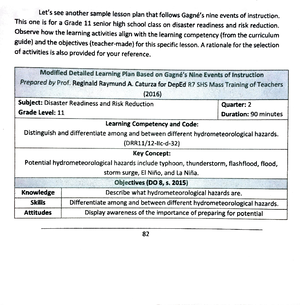- Information
- AI Chat
This is a Premium Document. Some documents on Studocu are Premium. Upgrade to Premium to unlock it.
Was this document helpful?
This is a Premium Document. Some documents on Studocu are Premium. Upgrade to Premium to unlock it.
Funstional and rehabilitative Model Report 2
Course: Beed GenEd
390 Documents
Students shared 390 documents in this course
University: University of Cebu
Was this document helpful?
This is a preview
Do you want full access? Go Premium and unlock all 2 pages
Access to all documents
Get Unlimited Downloads
Improve your grades
Already Premium?

Darlene: Hi everyone! We are the group 3 and we are going to discuss all about Functional/
Rehabilitation model. But before we finally precede to our main topic for today let us recall first
what is model of disability.
Coleen
What is model of disability?
It is a conceptual explanation of the process and underlying mechanism by which disease, injury
or birth defect impacts a person's ability to function. This model refers to a system of definition
and theories about human disabilities that are used to provide a framework for discussion or to
explain disabilities in relation to clinical diagnosis, rehabilitation medicine, employment issue,
public policymaking, and similar concerns.
What is Functional or rehabilitation model?
The functional or rehabilitation model is quite similar to the biomedical model in that it sees the
PWD as having impairment or deficits. Disability is caused by physical, medical or cognitive
deficits. The disability itself limits a person’s functioning or the ability to perform functional
activities.These deficits then justify the need to undergo rehabilitative intervention like the
therapies, counseling and the like in the aim of reintegrating that is able into society.
JOCELYN
This model of disability focuses on disability as deriving from an individual’s impairments or
deficits. Where this model differs from the medical approach is that, while the source of the
disability is individualistic and linked to medical, physiological, or cognitive impairments or
deficits, the expression of disability is the inability to perform a number of functional activities.
Example for biomedical model is mental retardation which is a condition of arrested or
incomplete development of the mind, which is especially characterized by impairment of
skills manifested during the developmental period, which contribute to the overall level of
intelligence such as cognitive, language, motor, and social abilities or condition.
Whilst, the logic of the functional approach is to focus program delivery on individuals who need
services to function.
Like a cripple person, this belongs to the functional/ rehabilitation model. A cripple is a disability
where in a person is unable to walk because of an injury or illness. The underlying presumption
of the functional model is that, while acknowledging the condition or pathological source of the
disability, the most important part of the disability is the disruption in functioning.
The functional model considers the expression of disability as something that can be treated
much like a doctor treats a disease and it stresses the adoption of a treatment regimen,
strategy, or service that improves functional capacity rather than addressing the underlying
condition or impairment.
DARLENE
Why is this page out of focus?
This is a Premium document. Become Premium to read the whole document.
Students also viewed
Related documents
- School Survey Report - Documents about different subjects that I already submitted. Documents and notes
- New testament - More info about Ict topic
- Learning insights about the labor code of the Philippines
- Jeffapksdaohsdfdg - Lecture notes 9
- Menstrual-cramps - Lecture notes 1,2,3
- ILA # 6 - Learning Theories in Social Studies Experiential Learning Theory




